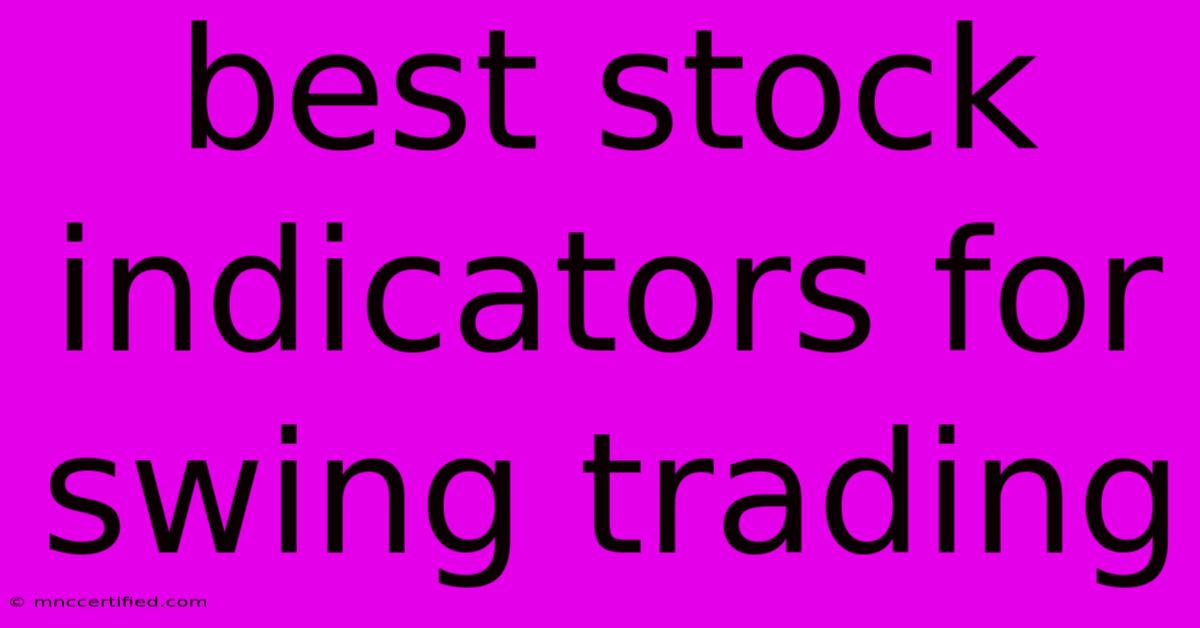Best Stock Indicators For Swing Trading

Table of Contents
Best Stock Indicators for Swing Trading: A Comprehensive Guide
Swing trading, a popular short-term strategy, involves holding trades for a few days to a few weeks, aiming to capture price swings in the market. Choosing the right indicators can be crucial for success in this fast-paced trading style. This article will guide you through some of the best stock indicators for swing trading, explaining their strengths, weaknesses, and how to implement them effectively.
Understanding the Importance of Indicators in Swing Trading
Stock indicators are mathematical calculations based on historical price and volume data. They help traders identify potential entry and exit points, track momentum, and analyze market trends. In swing trading, where timing is key, these indicators serve as valuable tools to:
- Identify potential support and resistance levels: Key indicators help traders pinpoint price levels where the market might reverse, giving them a heads-up for potential entry or exit points.
- Gauge momentum and trend strength: Swing traders rely on momentum indicators to confirm a trend's strength and identify when a trend might be reversing.
- Confirm trade setups: Indicators can be used alongside other technical analysis techniques to increase confidence in a trade setup, reducing the risk of false signals.
Top Stock Indicators for Swing Trading
Here are some of the most effective stock indicators for swing trading, along with their functionalities and best practices:
1. Moving Averages (MAs):
Function: Moving averages are widely used indicators that smooth out price data over a specific period. They reveal the overall trend direction and provide potential support and resistance levels.
Types of Moving Averages:
- Simple Moving Average (SMA): Calculates the average price over a set period.
- Exponential Moving Average (EMA): Gives more weight to recent prices, making it more responsive to price changes.
Best Practice: Combine different MA periods (e.g., 50-day and 200-day SMA) to create a crossover system. A bullish crossover occurs when a shorter-term MA crosses above a longer-term MA, indicating potential upward momentum.
2. Relative Strength Index (RSI):
Function: The RSI measures the magnitude of recent price changes to evaluate overbought or oversold conditions in a stock.
Interpretation:
- RSI above 70: Overbought, suggesting a possible pullback.
- RSI below 30: Oversold, indicating potential for a bounce back.
Best Practice: Combine the RSI with other indicators to confirm signals. Look for divergences between the RSI and price action.
3. MACD (Moving Average Convergence Divergence):
Function: The MACD identifies trend changes and potential buy and sell opportunities. It consists of two moving averages (12-period and 26-period EMA) and a signal line (9-period EMA).
Interpretation:
- Crossovers: Bullish crossover when the MACD line crosses above the signal line, bearish crossover when it crosses below.
- Divergences: A divergence occurs when the MACD is showing a different trend than the price.
Best Practice: Use the MACD in conjunction with other indicators, especially during periods of high volatility.
4. Stochastic Oscillator:
Function: The Stochastic Oscillator measures the closing price of a stock relative to its price range over a specific period.
Interpretation:
- Overbought (Above 80): The stock has moved too high too quickly, suggesting potential for a reversal.
- Oversold (Below 20): The stock has moved too low too quickly, indicating potential for a rebound.
Best Practice: Look for bullish divergences (price makes a lower low, but the Stochastic Oscillator makes a higher low) and bearish divergences (price makes a higher high, but the Stochastic Oscillator makes a lower high).
5. Bollinger Bands:
Function: Bollinger Bands plot two standard deviations above and below a moving average (typically a 20-period SMA).
Interpretation:
- Volatility: Wider bands indicate increased volatility, narrower bands suggest lower volatility.
- Breakouts: A price breakout beyond the bands suggests strong momentum.
Best Practice: Use Bollinger Bands in combination with other indicators to confirm signals. Look for price bounces off the bands for potential entry points.
Conclusion: Finding the Right Indicators for Your Swing Trading Style
Ultimately, the best indicators for swing trading are those that align with your individual trading style and risk tolerance. Experiment with different combinations of indicators and backtest your strategies on historical data to find what works best for you. Remember, no indicator is perfect, and it is important to understand the limitations of each one. Combine technical analysis with fundamental research to make informed trading decisions and manage your risk effectively.

Thank you for visiting our website wich cover about Best Stock Indicators For Swing Trading. We hope the information provided has been useful to you. Feel free to contact us if you have any questions or need further assistance. See you next time and dont miss to bookmark.
Featured Posts
-
Above Ground Pool Pool Bonding Diagram
Nov 09, 2024
-
Tony Todd A Life Remembered 1954 2024
Nov 09, 2024
-
Onegroup Risk Management And Insurance
Nov 09, 2024
-
Motion To Modify Bond Conditions Texas
Nov 09, 2024
-
Cold Email Template Investment Banking
Nov 09, 2024